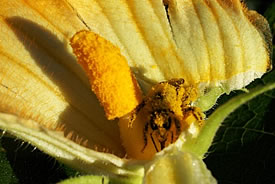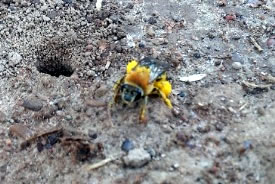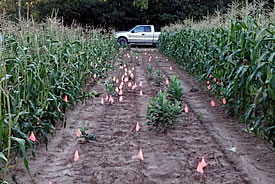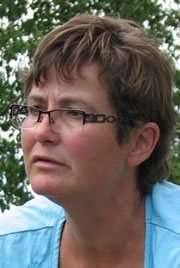It's the great pumpkin pollinator! Meet the squash bee

Female squash bee on a male pumpkin flower (Photo by Margaret Chan)
At my house, Halloween is a frenzy of pumpkins — those lovely globes that throb with the vitality of summer. We carve them into frightening orange-skinned, ghoulish-grinned beasts set aglow by the light of beeswax candles.
I fell in love with pumpkins in 1989 as a graduate student in Professor Peter Kevan’s lab at the University of Guelph. Picture me, trailing along behind Peter at a pumpkin farm in the early morning. He bent down to a pumpkin flower, picked out a grey-striped bee slathered with bright yellow pollen and handed it to me. I took it gingerly in my hands, briefly making contact before the bee flew away. No stinging, only wonder.
That was how I met the bee commonly known as the squash bee, which pollinates pumpkins and squashes. I spent the next two summers getting up at four in the morning and heading out to the pumpkin patch so that I could observe and study its behaviour.
Really it’s the bee, the pollinator of pumpkins, that I fell in love with. But the pumpkin is a symbol of that bee, a reminder to me in the darkening days of autumn of the beauty of that strange insect-mediated form of plant sex that gives humans, the bees themselves and so many other creatures food to sustain us.
We owe the presence of the squash bee (Peponapis pruinosa) in Ontario to First Nations peoples: squash bees are thought to have migrated from Central America following the cultivation of squash. These bees, now widespread in southern Ontario, are quintessential agricultural bees because they forage for pollen only on plants in the genus Cucurbita, represented here entirely by a small group of agricultural crops including pumpkins, squashes, summer squashes and gourds.

Female squash bee near its nest entrance (Photo by Margaret Chan)
Like most native bees in Ontario, squash bees are solitary species that spends most of their life as a pre-pupa in the ground. However, for a few glorious weeks in summer coinciding with bloom in Cucurbita crops, squash bees are active as adults. During that period, adult squash bees mature sexually, mate on Cucurbita flowers, forage for the copious nectar and pollen resources offered by those flowers and build their nests by excavating vertical tunnels in the ground with side shafts to house their larvae.
Squash bees' daily activities are governed by the pumpkin or squash flowers’ daily rhythm: they begin to forage at dawn when a new crop of pumpkin or squash flowers open, and stop around noon when the day’s batch of flowers wilt. Mated females each spend the afternoon individually building their nests, laying eggs on the pollen provisions they have spent the morning collecting or resting in the nests. Unmated females and males spend the afternoon sleeping inside the protective space formed within wilted pumpkin/squash flowers. Next morning they chew their way out of the wilted flowers to begin a new day.

Squash bee nesting aggregation (Photo by Margaret Chan)
Because squash bees begin to forage for nectar and pollen on squash or pumpkin flowers at dawn, if their populations are large enough, they have often moved enough pollen from male to female flowers to pollinate the crop long before honey bees show up in the field, making the honey bees’ contribution to pollination superfluous.
Squash bees are not endangered. In fact, they are common. If you grow any of the Cucurbita crops on the farm or in your garden, these bees will inevitably show up to forage for nectar and pollen and provide reliable pollination services. And although they are common, these bees are important to us: they build up large stable populations around Cucurbita crops and can be managed for pollination.
But I am concerned. These are farm bees — they live and work on farms, farms that are increasingly using broad spectrum neonicotinoid insecticides to control such pests as the cucumber beetles and squash bugs that attack their Cucurbita crops. I understand the farmers’ need to protect their livelihood. Yet research clearly shows that neonicotinoids applied to pumpkin plants end up in the nectar and pollen of pumpkins. Larval squash bees eat that pollen and nectar exclusively. Worryingly, research also shows that the reproductive efficiency of the blue orchard bee (another solitary native bee) is drastically reduced by exposure to neonicotinoids.
Do neonicotinoids have a similar effect on squash bees? No one knows.
Can you see where I’m going with this? I fear that given enough exposure to neonicotinoids over enough seasons, I may be witness to a general decline in squash bee populations in Ontario. I fear that I may lose my beloved bee and that farmers, very few of whom know this bee exists, will lose their specialist pollinator without having been properly introduced! With the coincident decline of other pollinators including bumble bees and honey bees, I fear for pumpkins. Will we still have those beacons of light in the waning season?


